Many plants grow on rocks. They have shallow roots that can quickly grab hold of any cracks or crevices in the rock surface, and their leaves are often small and leathery to minimize water loss.
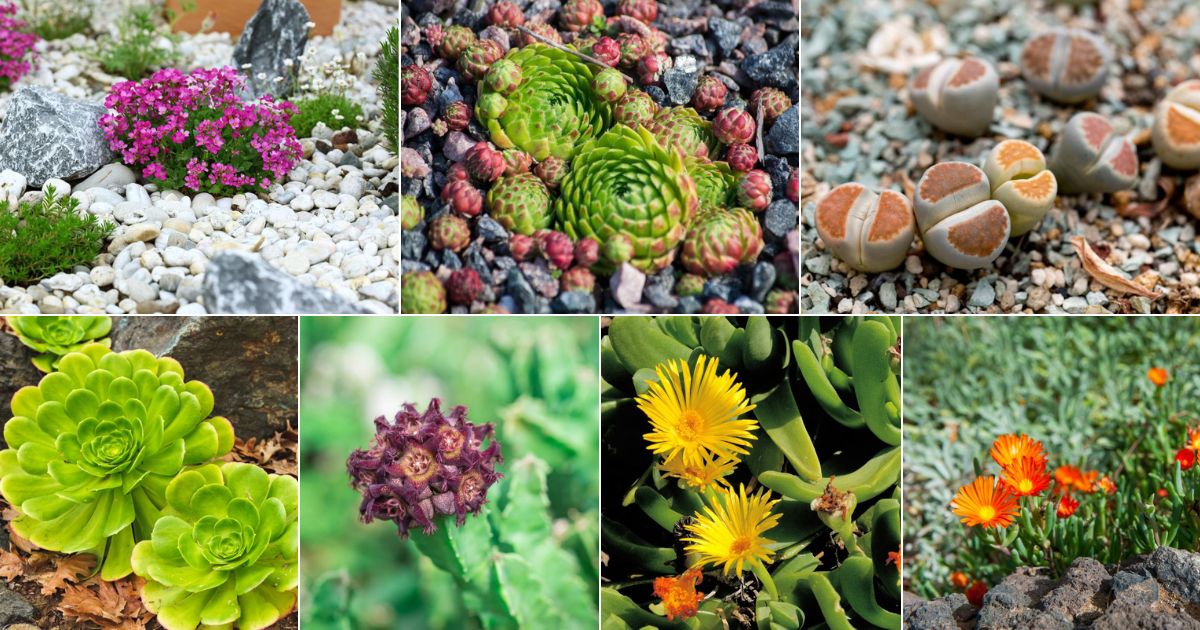
Some plants even have particular adaptations, like waxy coatings or hairy leaves, that help them survive in dry, rocky environments. These plants still need soil, but only a small amount that covers the roots.
Plants often store water in their leaves, which can help them survive if they're not receiving much moisture through the root system. Additionally, plants need water and nutrients, so plants tend to appear on rocks capable of absorbing the nutrients required for growth.
The best way to find out which plants will grow on your rocks is to talk to your local nursery or garden center. They will be able to tell you what plants are best suited for your particular climate and soil type. Here are twenty-five plants that grow on rocks:
Jump to:
Sedum
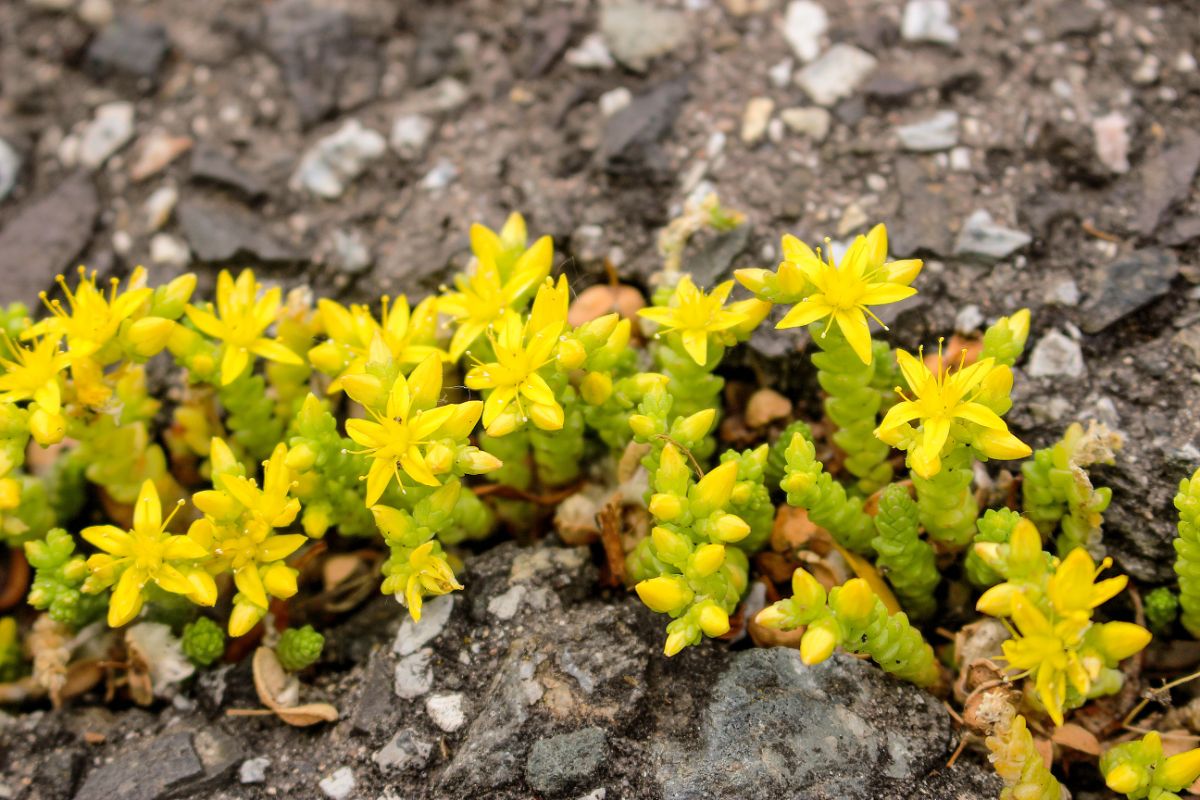
| Scientific Name: | Sedum acre |
| Plant Type: | annual, biennial, and perennial variants |
| Geographic Origin: | Asia and the Americas |
| Plant Size: | 6-24 inches tall |
| Sun Exposure: | full to partial |
| Plant Zone: | 3-11 |
Sedum is a genus of succulent plants. Sedum is often grown as ornamental plants. They typically have small, fleshy leaves and star-shaped flowers that attract butterflies. Another name is stonecrop. Varieties include Dragon’s Blood, Autumn Fire, and Coral Carpet.
Most Sedums will grow on rocks in partial shade. Creating a layer of well-drained soil, a layer of small stones, and a final layer of larger rocks will help your sedums thrive.
Sempervivum
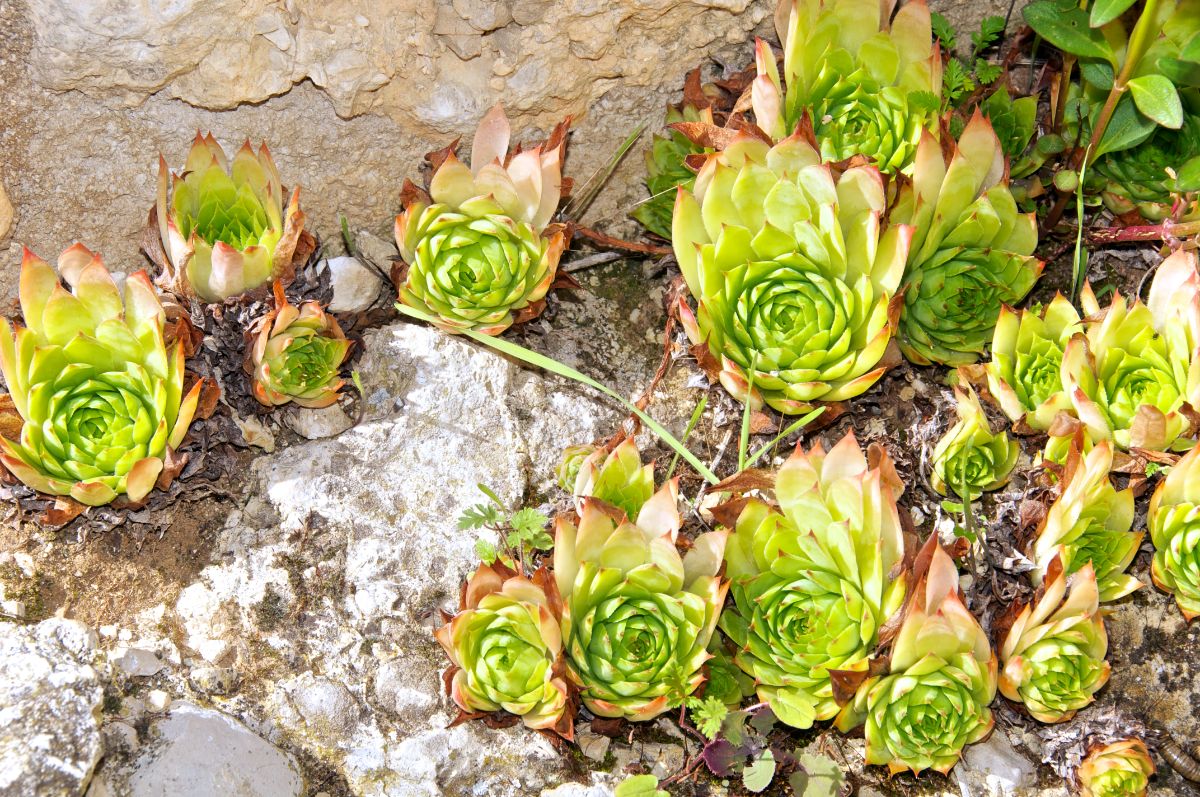
| Scientific Name: | L. Sempervivum tectorum |
| Plant Type: | annual and perennial variants |
| Geographic Origin: | Central and southern Europe |
| Plant Size: | .25 inch-thirteen inches diameter |
| Sun Exposure: | full to partial |
| Plant Zone: | 4-8 |
Sempervivums are also known as houseleeks or hen and chicks, and they are commonly grown as ornamental plants. They have thick, fleshy leaves and small flowers that grow in clusters. These plants grow easily as long as they have adequate sunlight and drainage.
Sempervivum can grow in dense layers and produce various red, orange, yellow, and pink shades. Sempervivum means "forever alive," which is good news for those lacking a green thumb.
Lithops
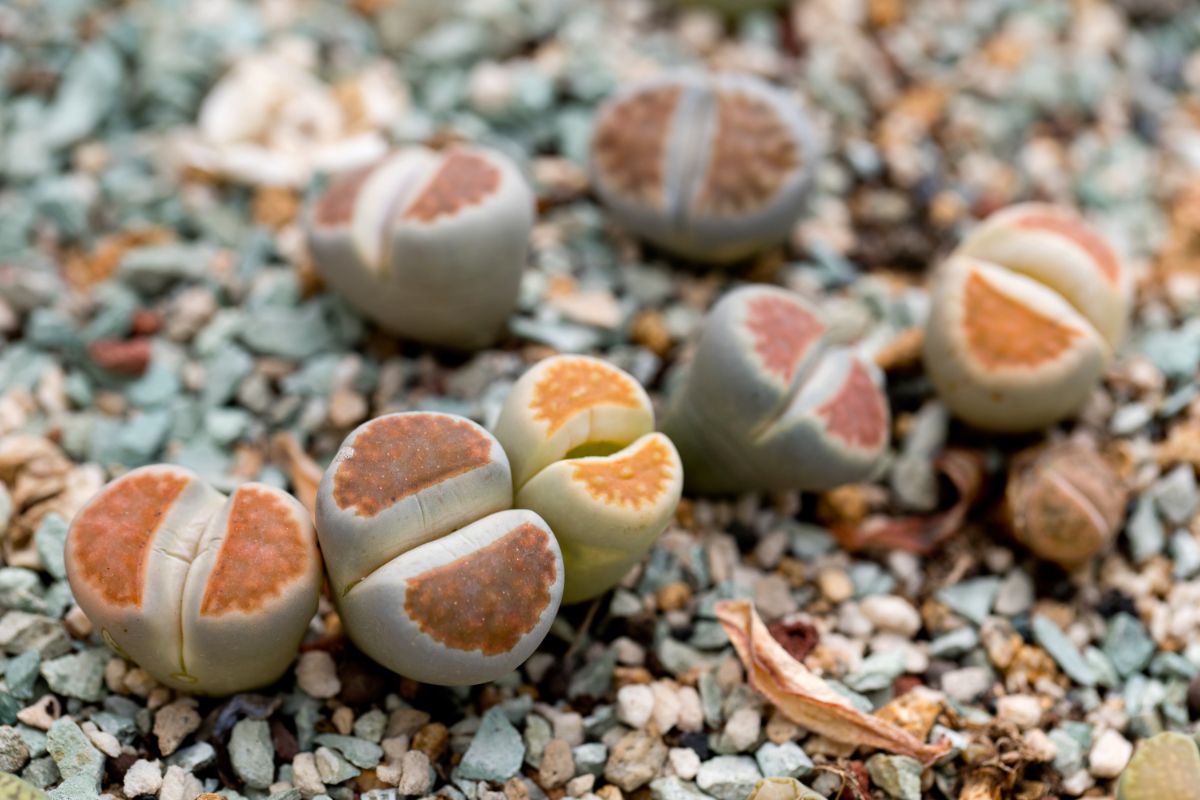
| Scientific Name: | Lithops optima |
| Plant Type: | annual variant |
| Geographic Origin: | Southern Africa |
| Plant Size: | .5 inch-1.5 inches tall |
| Sun Exposure: | full |
| Plant Zone: | 10-11 |
Lithops, or living stones, is a genus of succulent plants that includes more than forty species. Lithops are often grown as ornamental plants, and they are native to southern Africa.
They have thick, fleshy leaves that are often brightly colored or patterned. Lithops thrive in sandy soil and high temperatures. Most of the plant is underground as a moisture-saving feature. Lithops have transparent sections on their surface, increasing the amount of light entering the plant.
Crassula
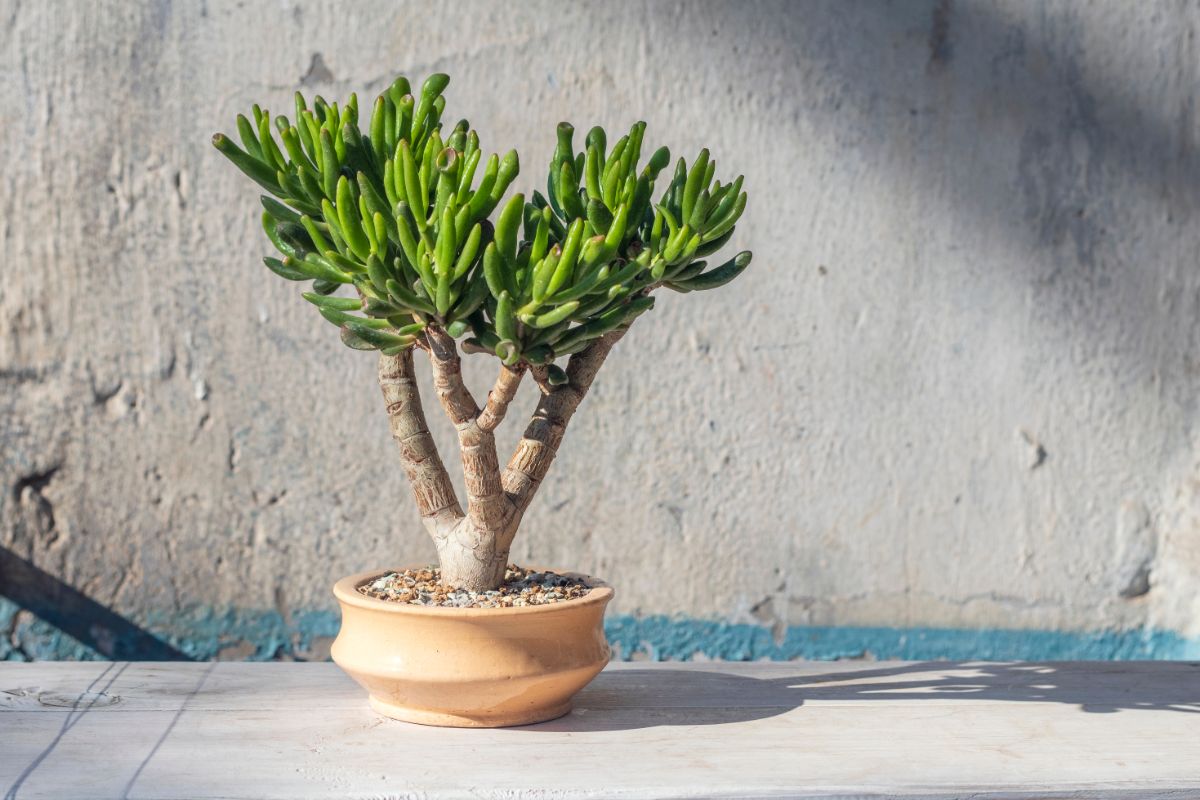
| Scientific Name: | Crassula ovata |
| Plant Type: | perennial variant |
| Geographic Origin: | South Africa, Mozambique, Swaziland |
| Plant Size: | 2-9 feet tall |
| Sun Exposure: | full to partial |
| Plant Zone: | 9-12 |
Crassula is a genus of succulent plants with more than three hundred species. Crassulas are native to many parts of the world, including Africa, Asia, and South America.
They typically have thick fleshy leaves and small flowers. The jade plant is the most popular species. Crassula does not need much water but is sensitive to temperature extremes. Partial sun is ideal.
Kalanchoe
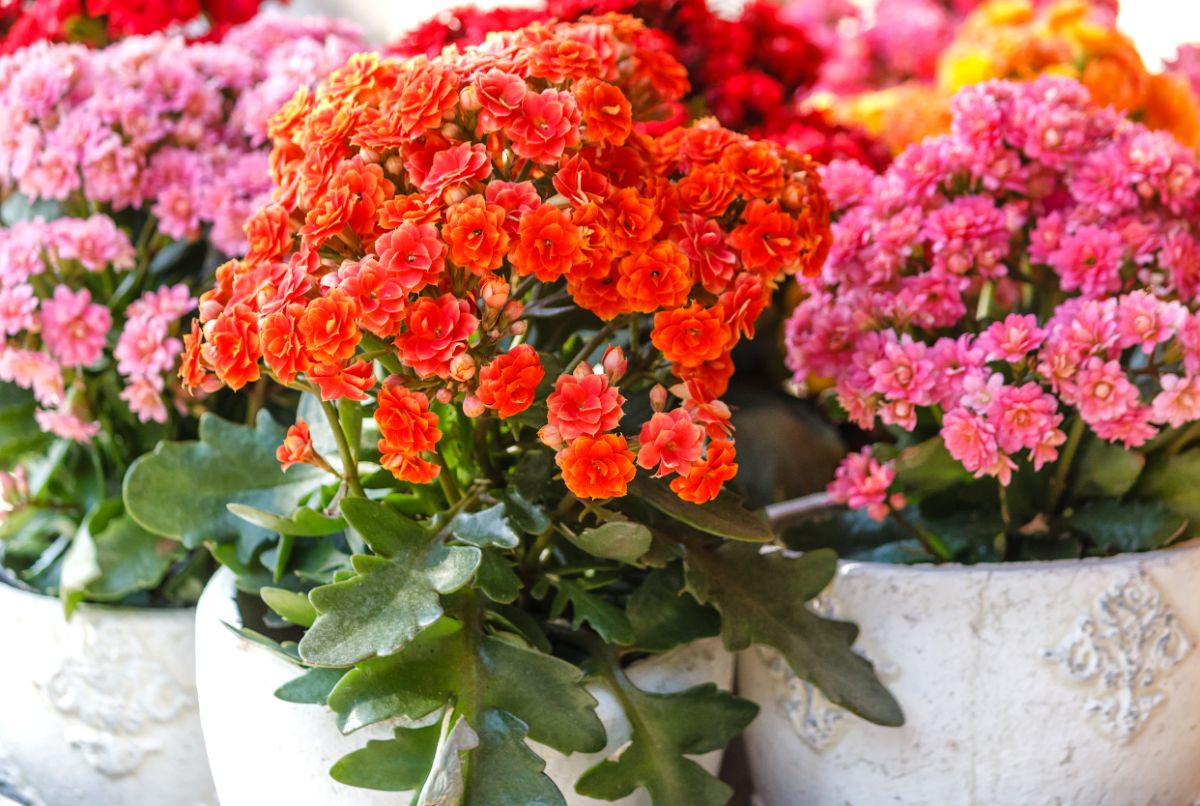
| Scientific Name: | Kalanchoe blossfeldiana |
| Plant Type: | perennial variant |
| Geographic Origin: | Madagascar |
| Plant Size: | 6-18 inches tall and wide |
| Sun Exposure: | full to partial |
| Plant Zone: | 10-12 |
Kalanchoe is a genus of succulent plants native to Madagascar and other parts of Africa. They typically have thick, fleshy leaves and tiny flowers that are white, red, and orange. Kalanchoe is poisonous, so be careful if you have pets around.
The leaves store moisture, much like cacti, so they don't need much water. Kalanchoe can tolerate sun and shade, and soil should remain dry. Kalanchoe needs to stay away from frost.
Portulacaria
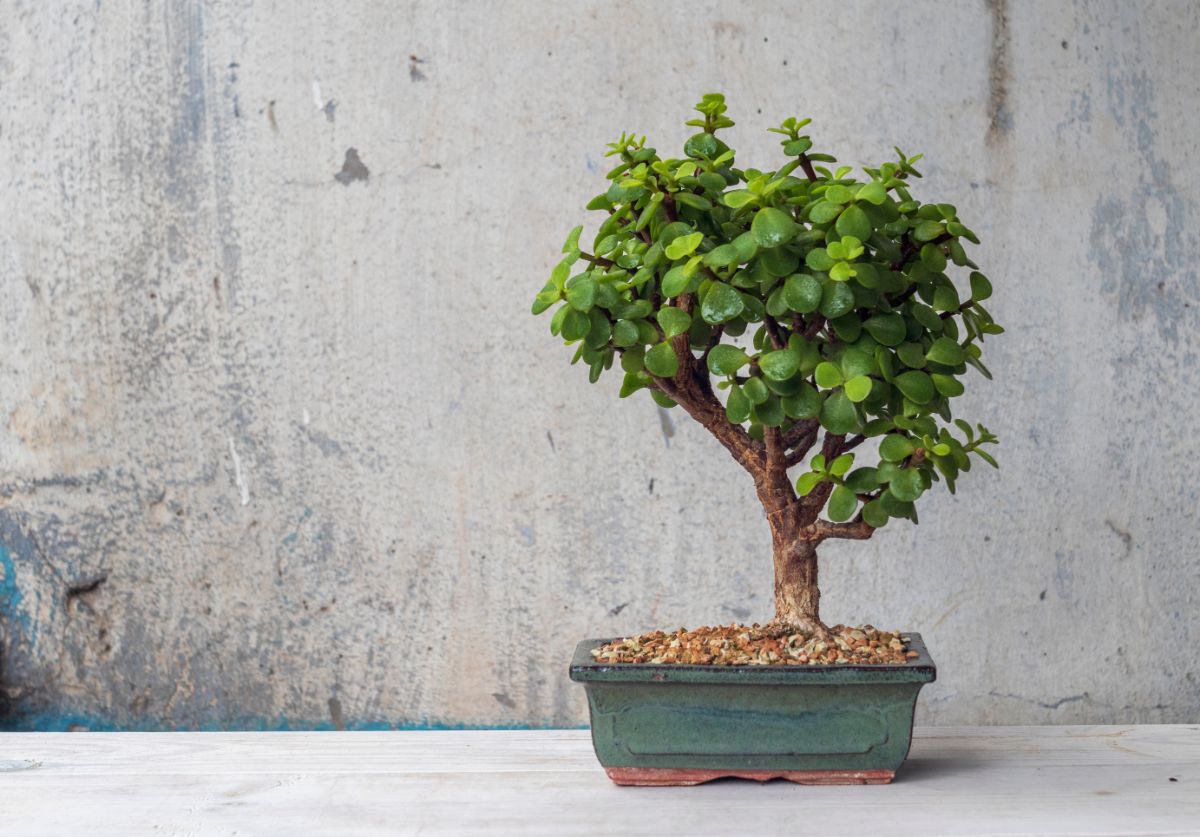
| Scientific Name: | Portulacaria afra |
| Plant Type: | perennial |
| Geographic Origin: | Southern Africa |
| Plant Size: | 3-6 feet tall |
| Sun Exposure: | full to partial |
| Plant Zone: | 9-11 |
Portulacaria, or Elephant Bush, is a genus of succulent plants that includes more than twenty species. Portulacarias are native to Africa. They typically have thick, fleshy leaves and small flowers.
This plant adapts well to different environments, including rocky areas. Portulacaria does well in dry climates and is a common choice for bonsai. People frequently eat these plants, and they absorb large amounts of atmospheric carbon.
Aeonium
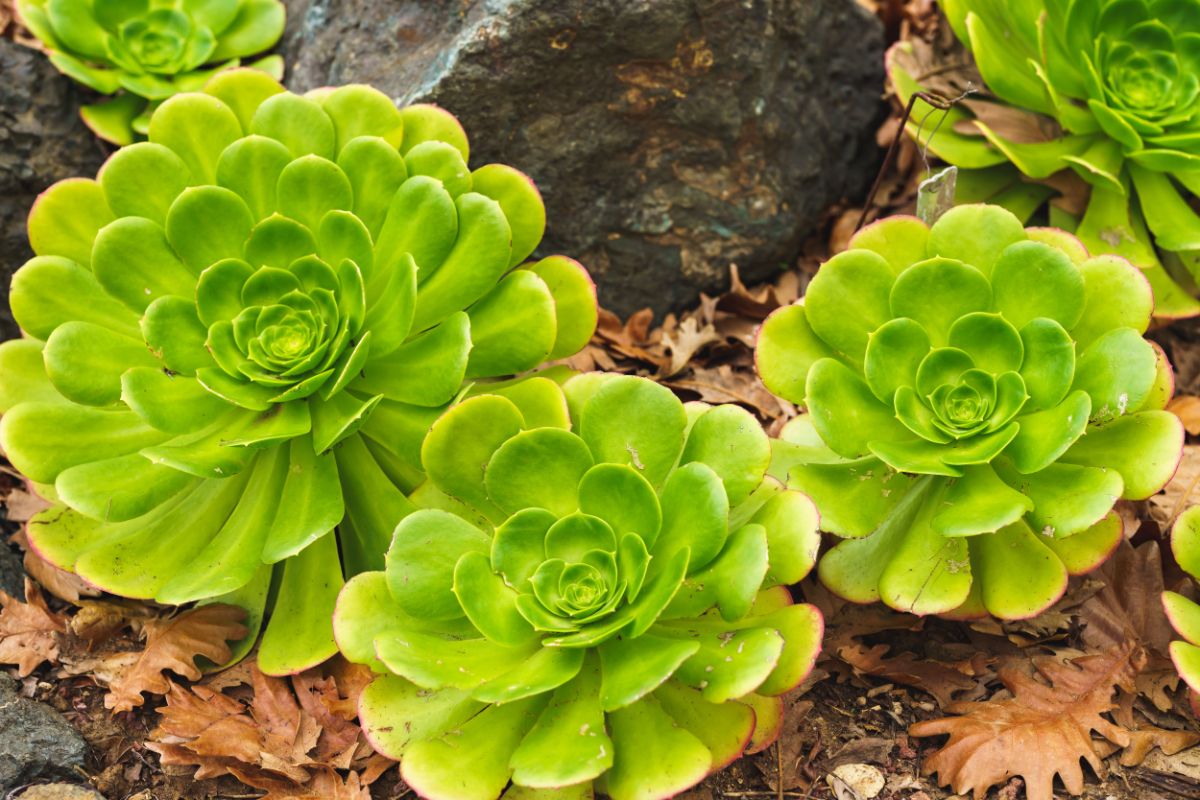
| Scientific Name: | Aeonium spp. |
| Plant Type: | perennial |
| Geographic Origin: | Canary Islands, Africa |
| Plant Size: | 2-60 inches tall |
| Sun Exposure: | full to partial |
| Plant Zone: | 9-11 |
Aeonium is native to Africa and the Canary Islands. These succulents typically display waxy, shiny leaves growing in rosettes. Small flowers grow in the center of the rosettes, which may be green, yellow, white, or red. Aeoniums prefer damp soil and die after blooming.
Aeoniums grow in rocky volcanic conditions in the wild, so you should not have many issues introducing them to your yard.
Aloinopsis
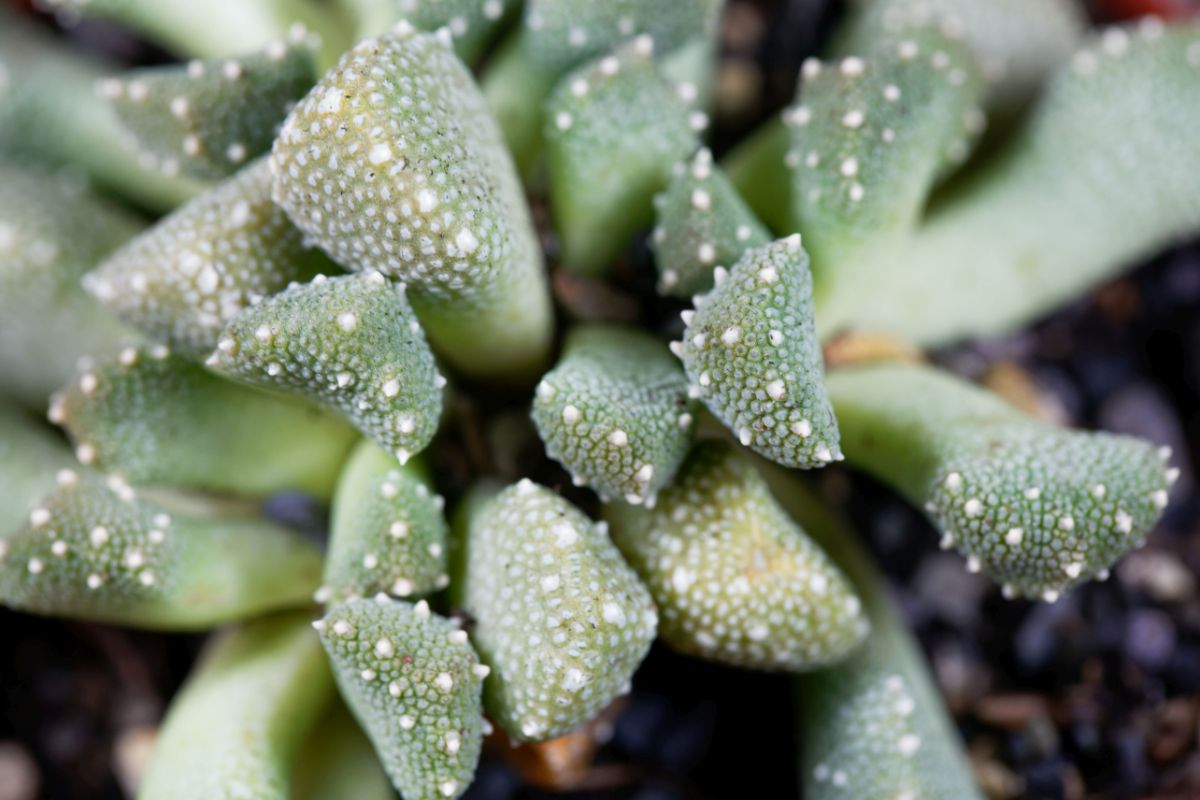
| Scientific Name: | Aloinopsis luckhoffii |
| Plant Type: | perennial |
| Geographic Origin: | Southern Africa |
| Plant Size: | 2 inches tall, 12 inches wide |
| Sun Exposure: | full |
| Plant Zone: | 6-9 |
Aloinopsis is a succulent native to South Africa. It grows during winter and needs a lot of direct light. The plant is dormant during summer, so it's important not to water too often during these months.
Aloinopsis has brilliant yellow flowers that slowly grow to cover the plant. Aloinopsis grows well on rocks as long as it gets enough sun.
Glottiphyllum
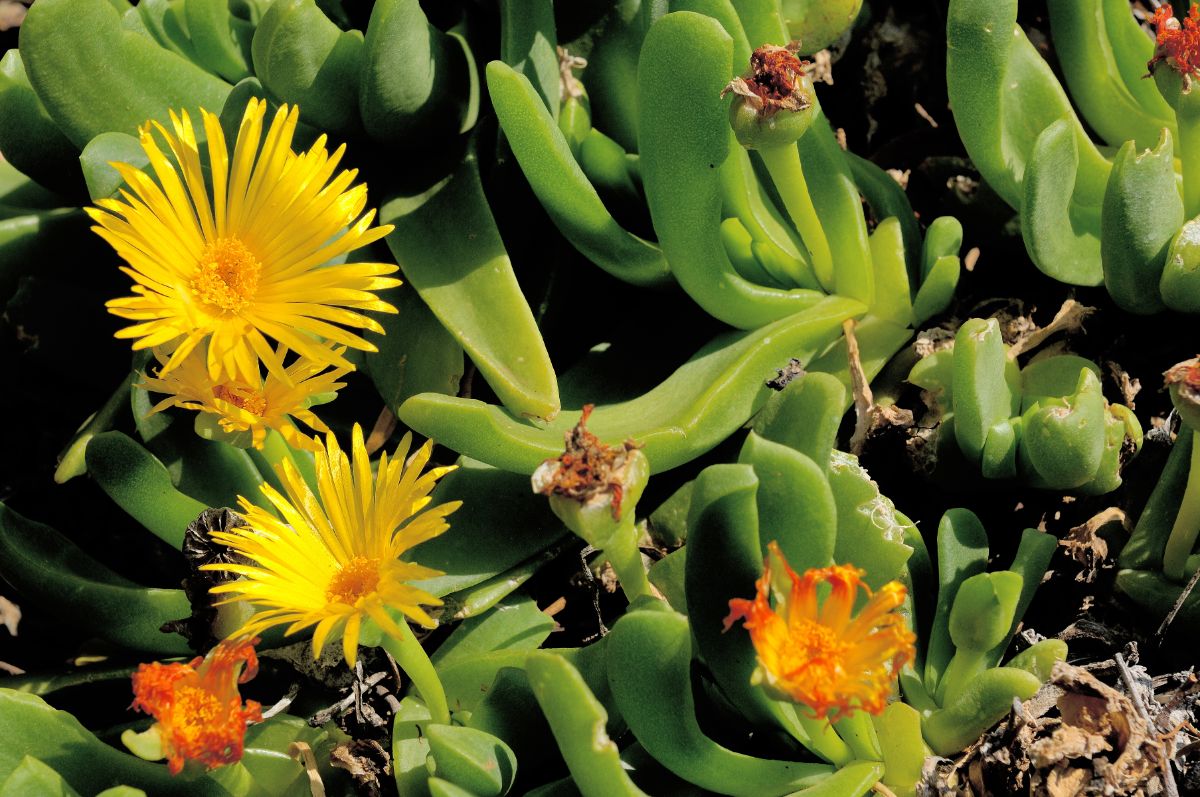
| Scientific Name: | Glottiphyllum regium |
| Plant Type: | perennial |
| Geographic Origin: | Southern Africa |
| Plant Size: | 5 inches tall, 6 inches wide |
| Sun Exposure: | full |
| Plant Zone: | 9-11 |
Glottiphyllum (Tongue-leaf Plant) is a genus of succulent plants native to Africa and Arabia. They have thick, elongated leaves and small flowers on the stalks.
Glottiphyllums don't need much water, but they grow best with a regular watering schedule. These plants like a lot of sunlight and dry roots. These do not do well sitting in dense soil.
Dudleya
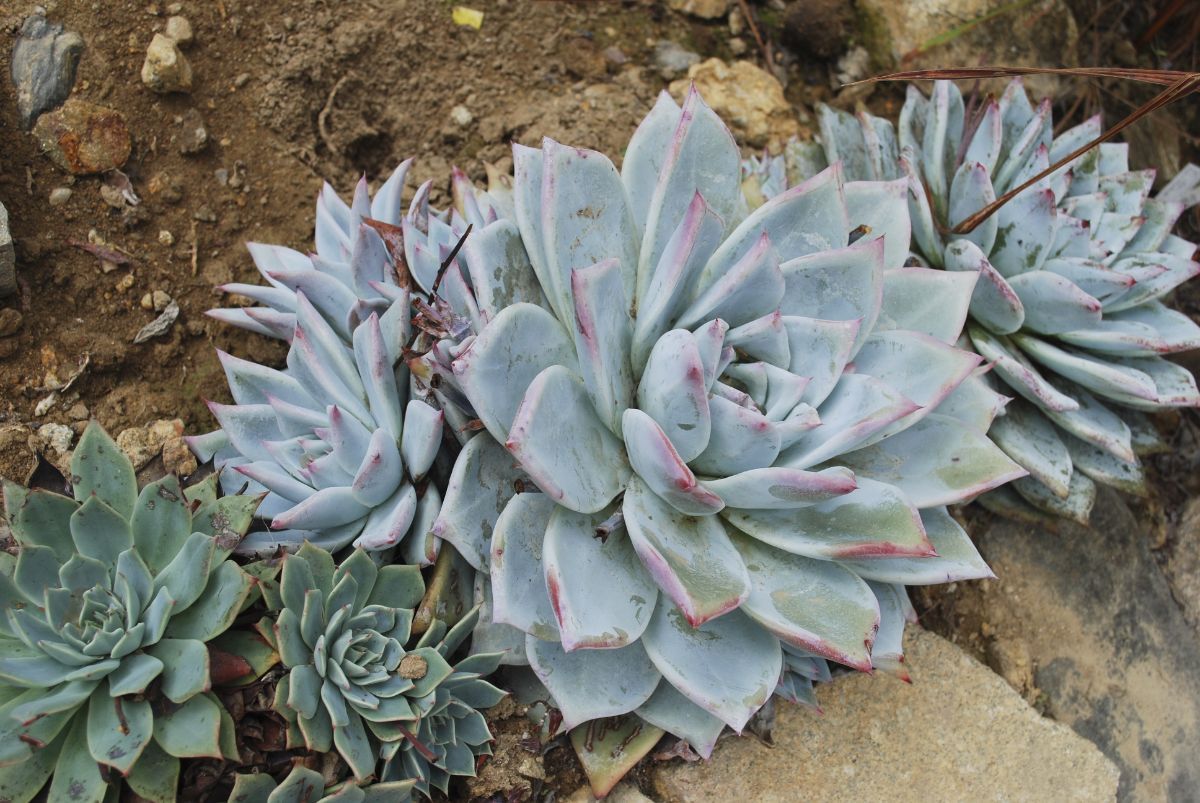
| Scientific Name: | Dudleya cymosa |
| Plant Type: | perennial |
| Geographic Origin: | Western US and Mexico |
| Plant Size: | 2 inches tall, 5 inches wide |
| Sun Exposure: | partial |
| Plant Zone: | 5-10 |
Dudleya is a genus of succulent plants that includes more than forty species. They typically have thick, fleshy leaves and small flowers.
These are hearty plants that require little maintenance and can live for extended periods. Dudleyas have a waxy coating that protects them from excessive sun. Removing this coating is one of the only ways to damage these plants.
Echeveria

| Scientific Name: | Echeveria agavoides |
| Plant Type: | perennial |
| Geographic Origin: | Central and South America |
| Plant Size: | 4 inches tall |
| Sun Exposure: | full to partial |
| Plant Zone: | 9-11 |
Echeveria is a genus of succulent plants native to Mexico and Central America. They typically have thick, fleshy leaves and small flowers. These plants are easy to care for and look great outdoors.
Echeverias need well-draining soil and should need water only when the soil is dry. They can tolerate various lighting conditions but prefer a good amount of sun.
Haworthia
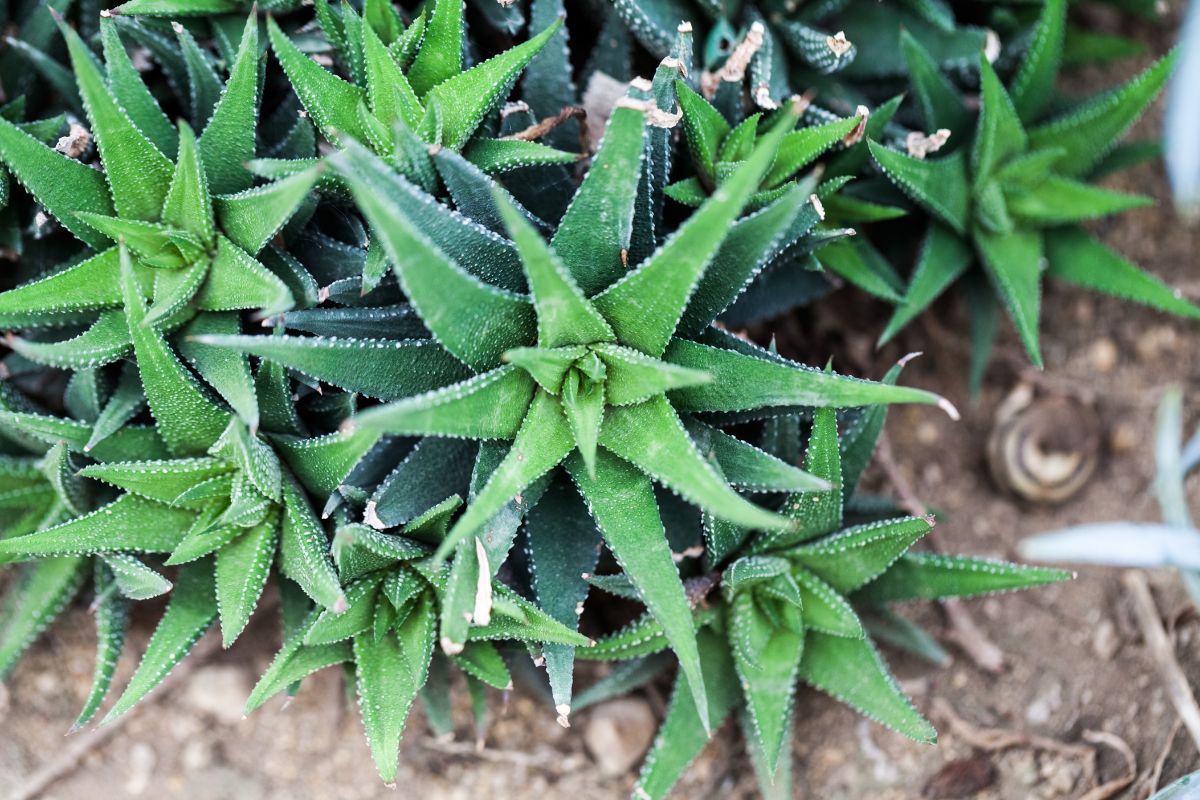
| Scientific Name: | Haworthia margaritifera |
| Plant Type: | perennial |
| Geographic Origin: | Africa |
| Plant Size: | 3-5 inches tall and wide |
| Sun Exposure: | full to partial |
| Plant Zone: | 9-11 |
Haworthia has thick, fleshy leaves and small white flowers. These succulents like indirect sunlight and enough water to keep the leaves from looking wrinkled. There are more than one hundred species of Haworthia. These plants grow slowly and can't handle cold temperatures.
Haworthias like partial shade and sandy/rocky soil.
Graptopetalum
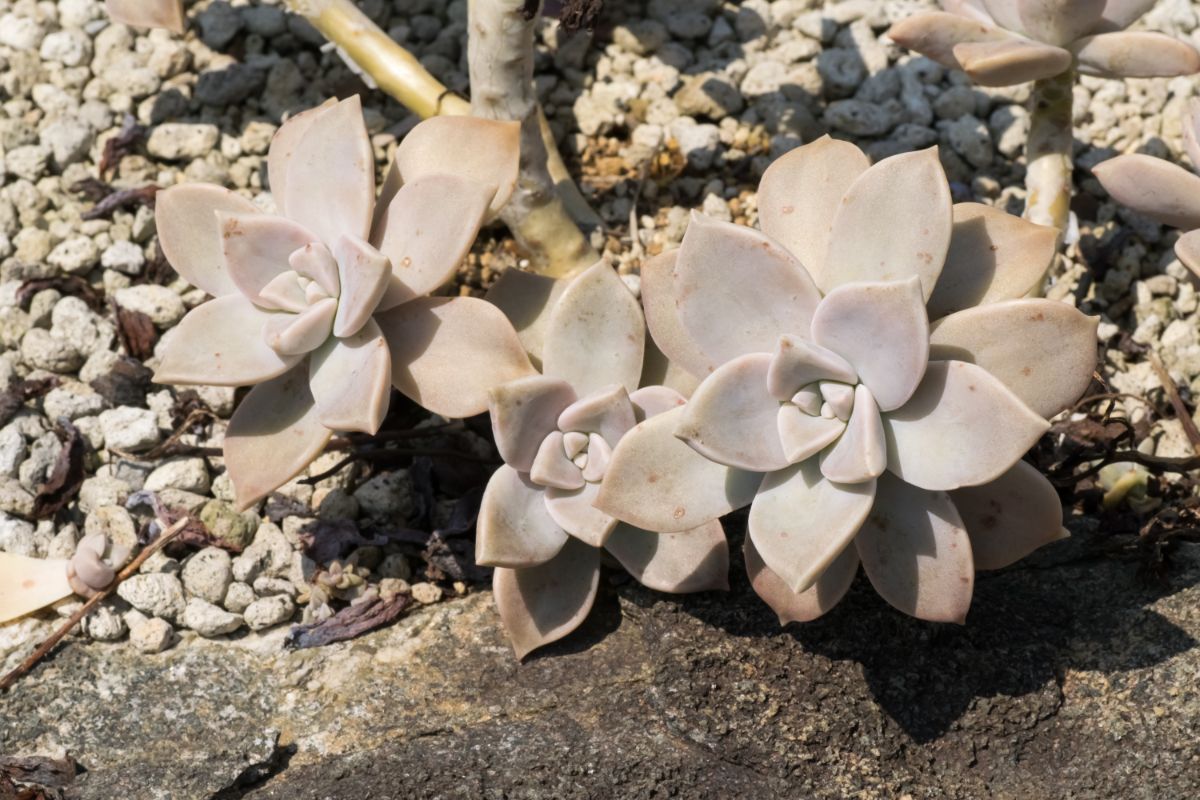
| Scientific Name: | Graptopetalum paraguayense |
| Plant Type: | perennial |
| Geographic Origin: | North and Central America |
| Plant Size: | 6-12 inches wide, 2-3 feet wide |
| Sun Exposure: | full to partial |
| Plant Zone: | 9-11 |
Graptopetalum (Ghost Plant) is a genus of succulent plants with more than thirty species. Graptopetalums are native to Mexico and the southwestern United States.
They typically have thick, fleshy leaves and small flowers. Graptopetalums are popular succulents because they are easy to care for and require little water. This plant can live for many years and will expand quickly in the proper conditions.
Hylotelephium
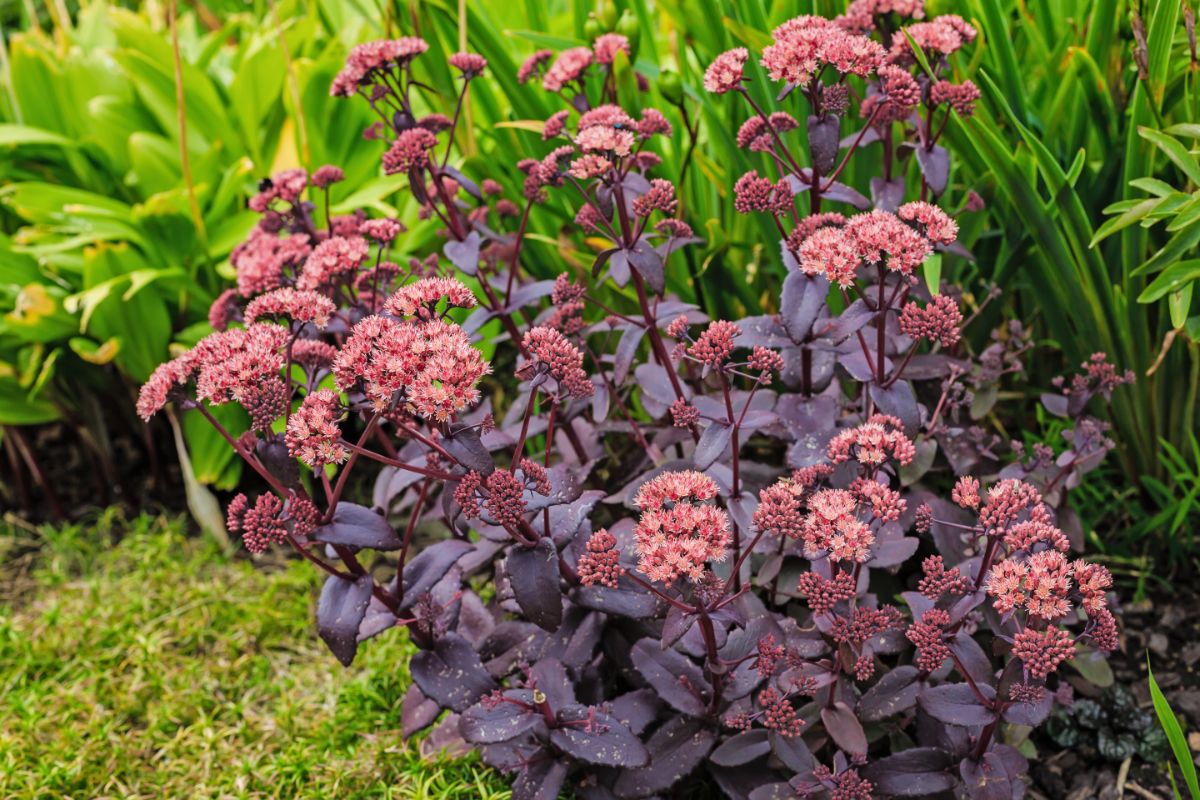
| Scientific Name: | Hylotelephium telephium |
| Plant Type: | perennial |
| Geographic Origin: | Europe and Asia |
| Plant Size: | 1-1.5 feet tall and wide |
| Sun Exposure: | full |
| Plant Zone: | 3-9 |
Hylotelephium (Autumn Joy) is a genus of succulent plants native to Europe and Asia. They typically have thick, fleshy leaves and small flowers. Many species of hylotelephium are popular garden plants, and they work well in rock gardens. Full sunlight ensures good flower production.
Hylotelephiums don't need much moisture and are, in fact, drought-resistant. This plant is so tough that it can handle high heat down to frost, although it eventually will die if temperatures stay very cold.
Jovibarba
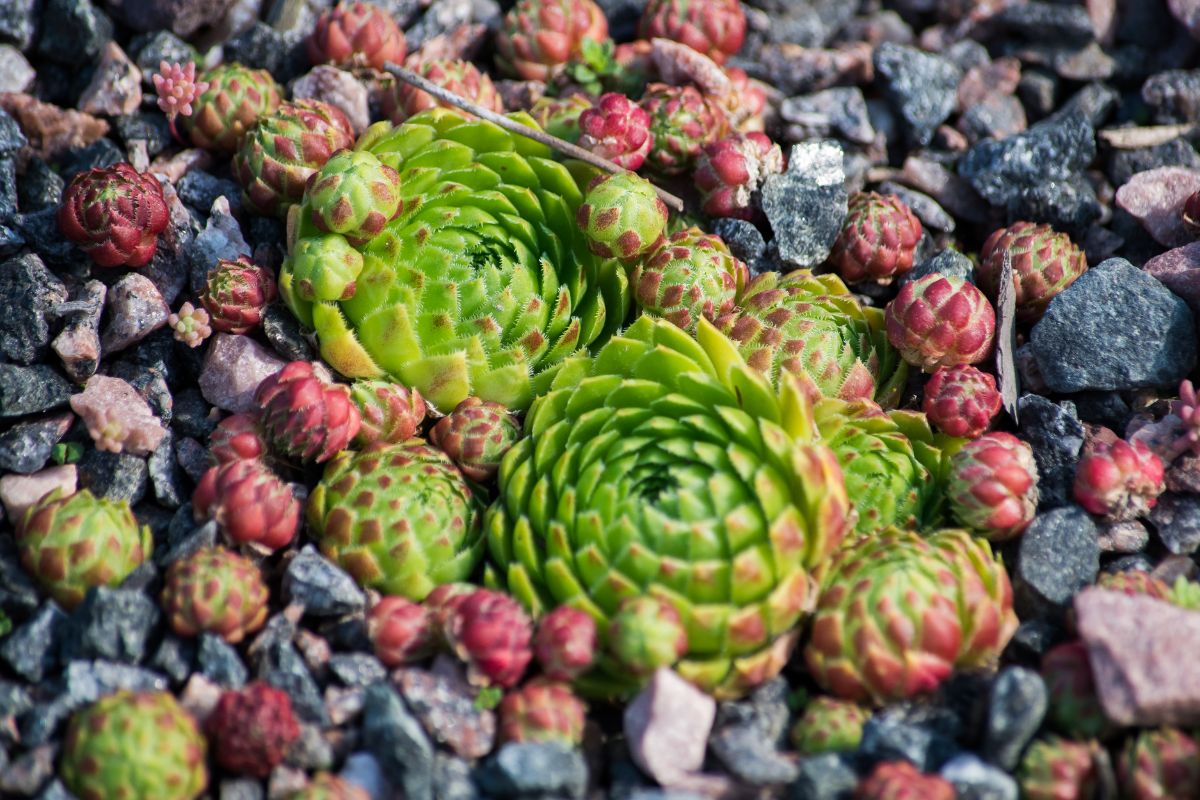
| Scientific Name: | Jovibarba globifera |
| Plant Type: | perennial |
| Geographic Origin: | Alps, the Carpathians, the western Balkans, northern Albania |
| Plant Size: | 2 inches tall, 4 inches wide |
| Sun Exposure: | full |
| Plant Zone: | 5-9 |
Jovibarba is similar to Sempervivum and is native to Europe and Asia. They typically have thick, fleshy leaves and small flowers. Flowers generally don't emerge for two-to-three years. Many species of Jovibarba are tolerant of drought and poor soil conditions, meaning they do well on rocks. Jovibarbas can tolerate temperatures of negative ten degrees Fahrenheit.
Sedeverias
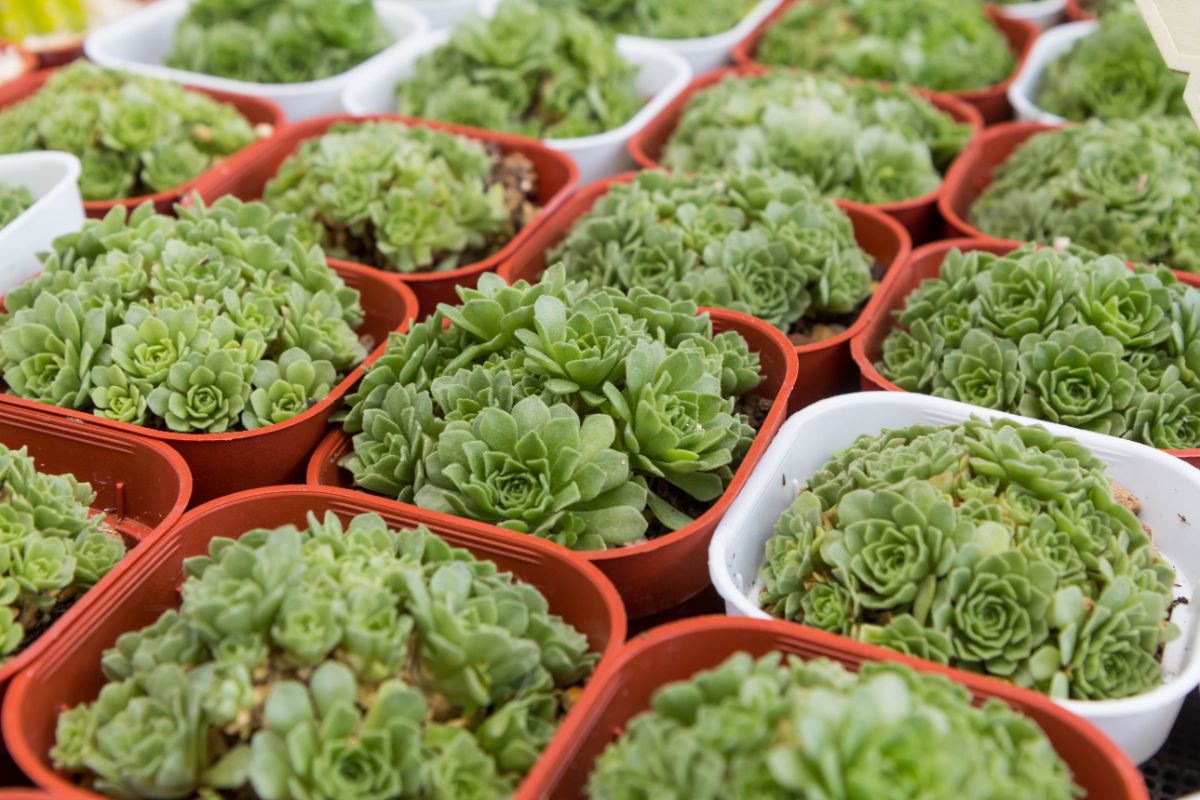
| Scientific Name: | Sedeveria letizia |
| Plant Type: | perennial |
| Geographic Origin: | North and Central America |
| Plant Size: | 3 inches tall, six inches wide |
| Sun Exposure: | full to partial |
| Plant Zone: | 9-11 |
Sedeverias are another family of succulents that thrive on rocks. These plants are native to Mexico and the southwestern United States. They typically have thick, fleshy leaves and small flowers.
Beautiful rosettes identify these plants, often blue-green and silver-green. As long as temperatures aren't too cold, Sedeverias don't need much care. Even moderate rain means you should not water these hearty succulents.
Sinocrassula
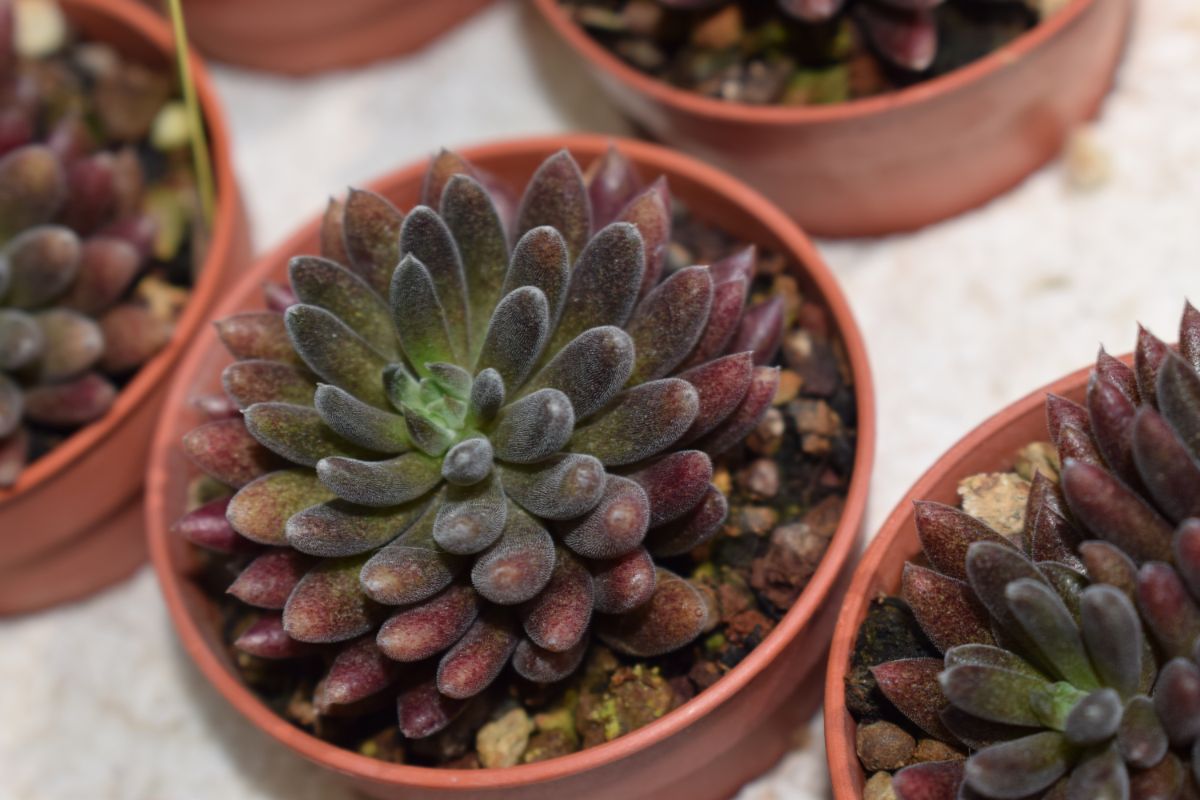
| Scientific Name: | Sinocrassula yunnanensis |
| Plant Type: | Perennial |
| Geographic Origin: | China, Japan |
| Plant Size: | 4 inches tall |
| Sun Exposure: | full to partial |
| Plant Zone: | 7-11 |
Sinocrassula is a genus of succulent plants that includes more than twenty species. Sinocrassulas are native to China and Japan. They typically have thick, fleshy leaves and small flowers.
Chinese Jade is a sinocrassula. These plants have a shallow root system but need space to grow horizontally. Partial sun is enough for sinocrassula, and the roots mustn't sit in water because they will rot.
Stapelia
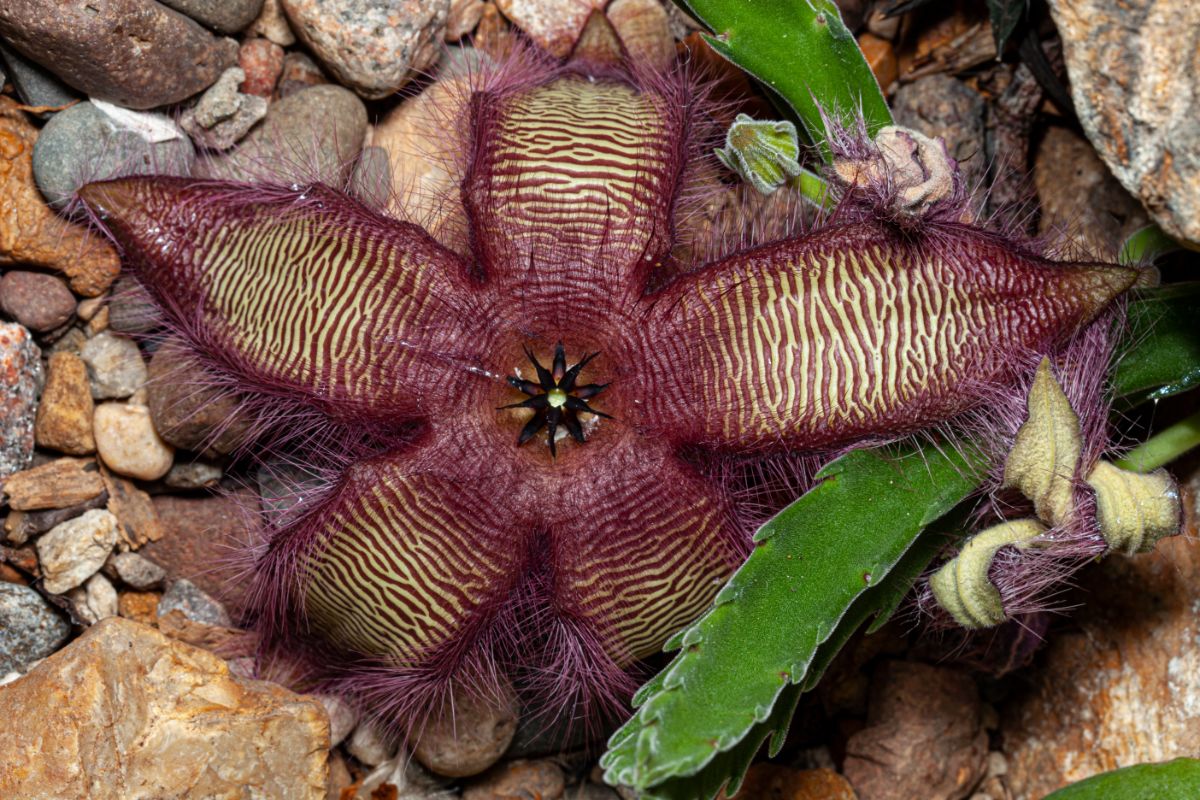
| Scientific Name: | Stapelia hirsuta |
| Plant Type: | perennial |
| Geographic Origin: | Southern Africa |
| Plant Size: | .5-1 feet tall, 1-2 feet wide |
| Sun Exposure: | full |
| Plant Zone: | 9-10 |
Stapelia is a genus of succulent plants that are native to Africa. They typically have thick, fleshy leaves and large, often foul-smelling flowers. These flowers are very furry and unusual looking. These are desert succulents, so they like lots of hot sun and infrequent watering.
Stapelias come from parts of Africa without pollinator bees. The hair, smell, and fleshy colors have evolved to trick insects into thinking these plants are carrion.
Tylecodon
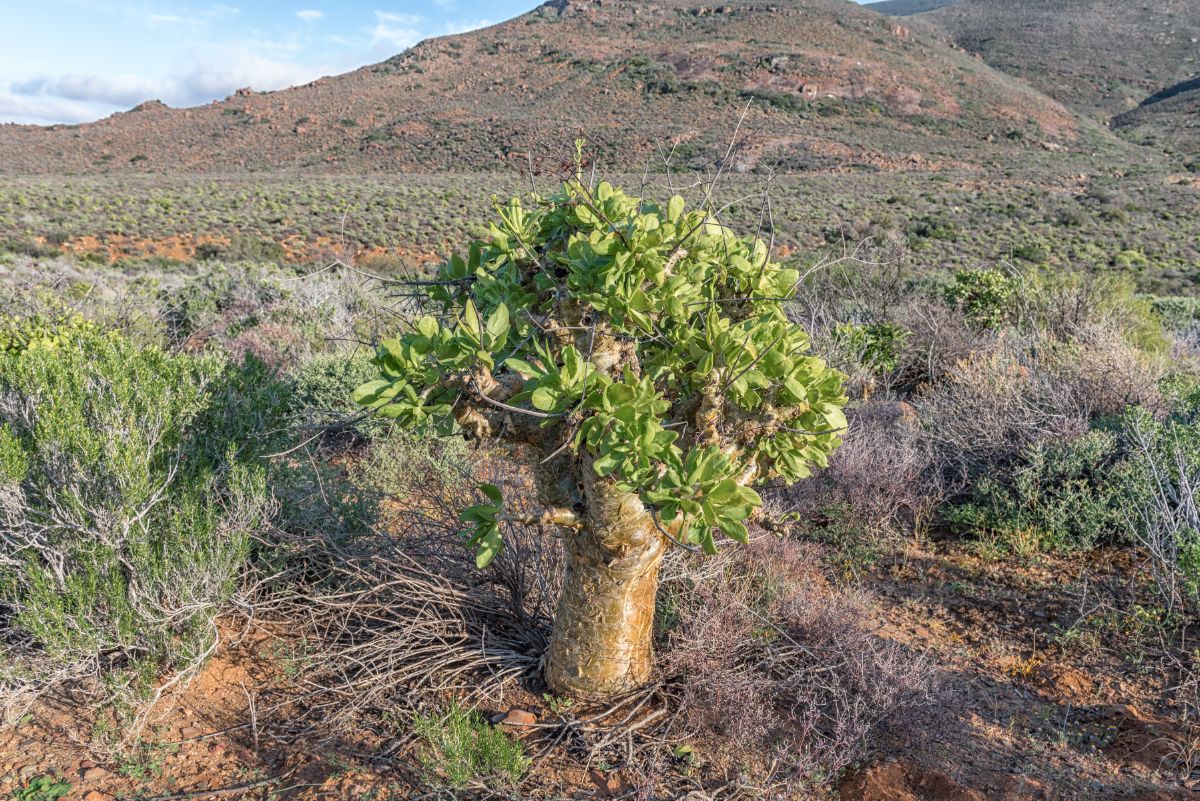
| Scientific Name: | Tylecodon paniculatus |
| Plant Type: | perennial |
| Geographic Origin: | Southern Africa |
| Plant Size: | 4 feet tall, 3-5 feet wide |
| Sun Exposure: | full to partial |
| Plant Zone: | 9-11 |
Tylecodon is a genus of succulent plants that includes more than forty species. Tylecodons are native to southern Africa, and they typically have thick, fleshy leaves and small flowers. These plants thrive in rocky environments. Many species are toxic and should are not a good choice if you have pets. Flowers appear in spring after the leaves fall off.
Adromischus
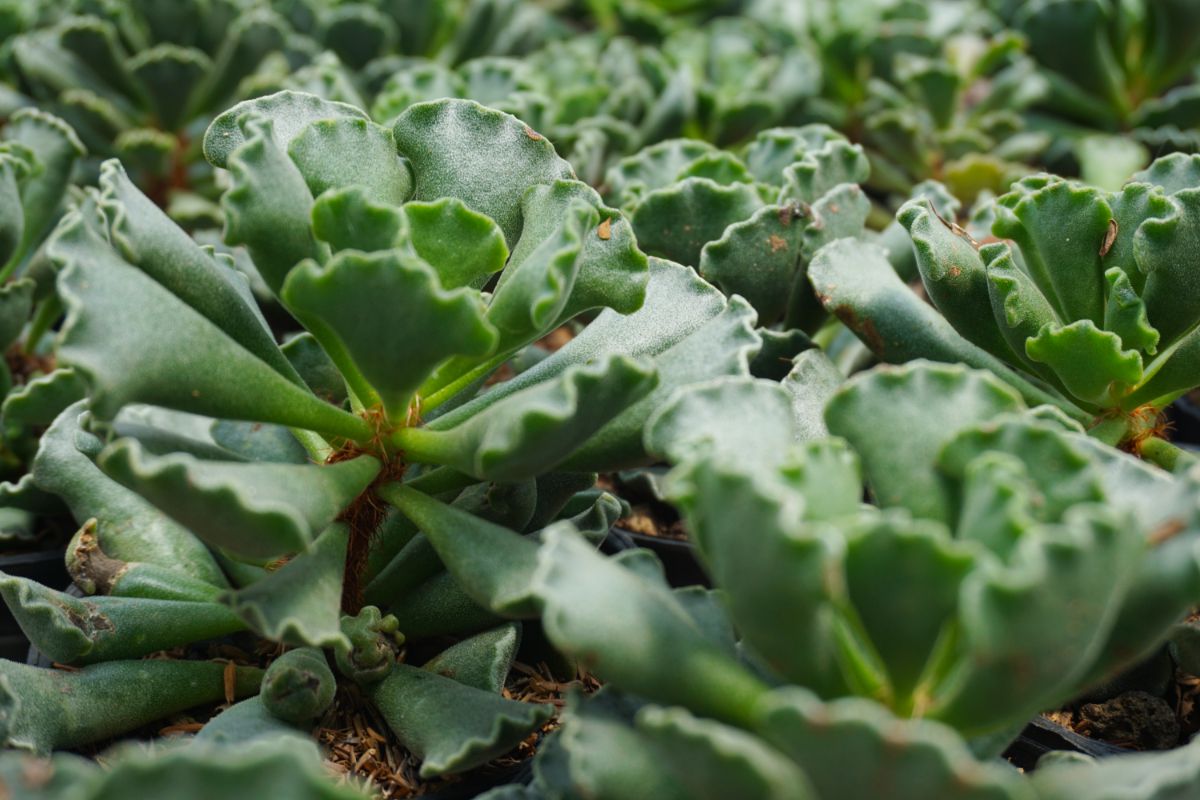
| Scientific Name: | Adromischus cristatus |
| Plant Type: | perennial |
| Geographic Origin: | South Africa |
| Plant Size: | 6 inches tall |
| Sun Exposure: | full to partial shade |
| Plant Zone: | 10-11 |
Adromischus is a genus of succulent plants that includes more than thirty species. Adromischuses are native to South Africa. They typically have thick, fleshy leaves and small flowers.
Thes plants are versatile and grow in many rocky environments. They like quartz, sandstone, and granite. It’s common for an Adromischus to begin life as a seed blown into a rock crevice.
Fockea
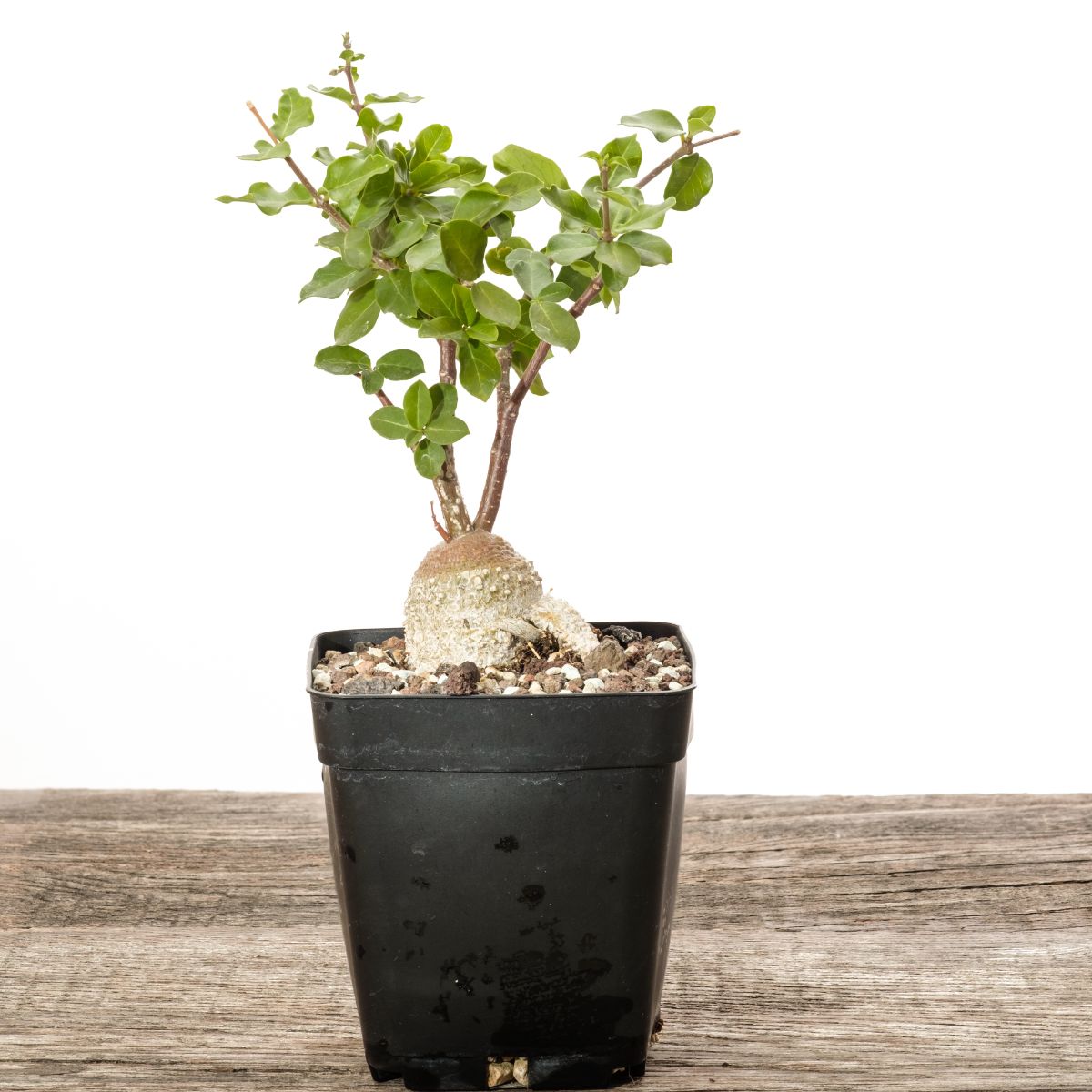
| Scientific Name: | Fockea edulis |
| Plant Type: | perennial |
| Geographic Origin: | Southern Africa |
| Plant Size: | 18 inches tall, can climb up to 20 feet |
| Sun Exposure: | full to partial |
| Plant Zone: | 9 |
Fockea is a genus of succulent plants with thick, bulbous roots. The roots store water for the plant to use during droughts. Fockeas are often used as ornamental plants and can weigh up to one hundred pounds. Many species of Fockea are climbers and can reach up to twenty feet in length.
These succulents like bright sunlight but can tolerate some shade. They need well-draining soil and only need water when the soil is dry. The root system is capable of providing most moisture needs for the plant.
Fockeas grow on rocks and sandy areas in the wild and thrive in various temperatures.
Argyroderma
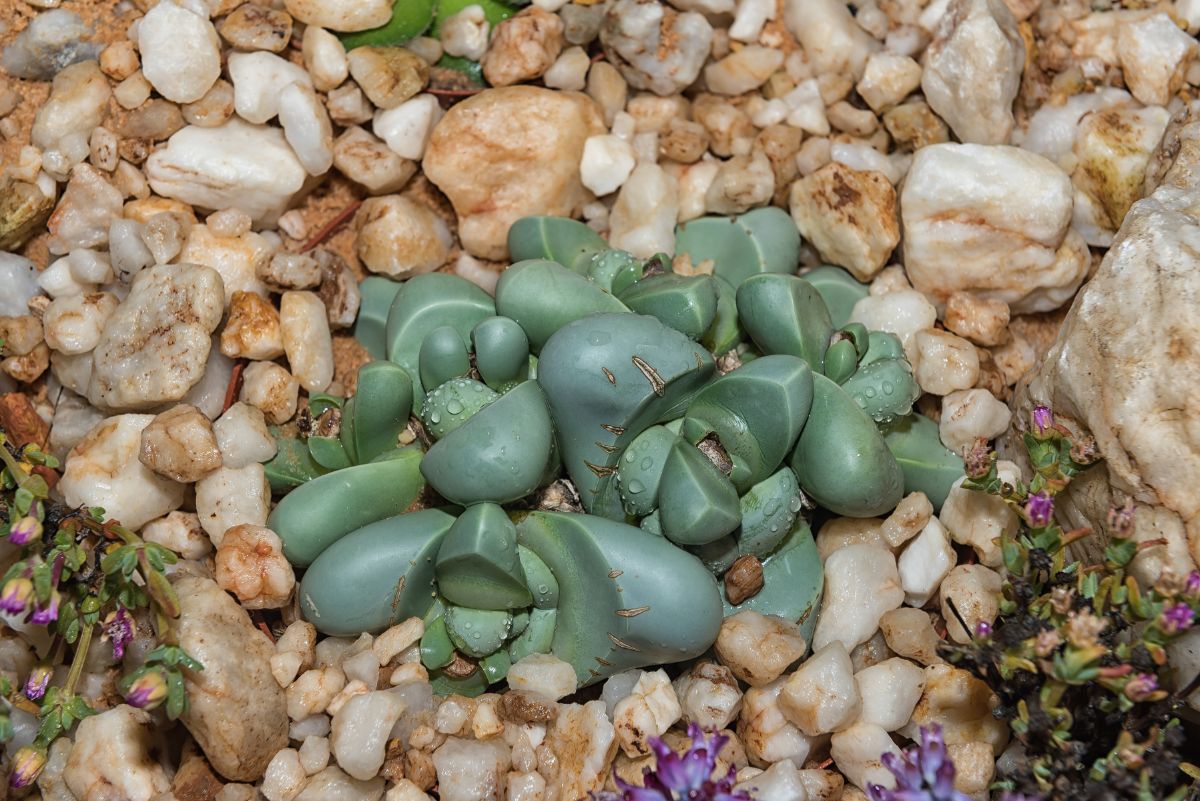
| Scientific Name: | Argyroderma patens |
| Plant Type: | perennial |
| Geographic Origin: | South Africa |
| Plant Size: | 6 inches tall and wide |
| Sun Exposure: | full to partial |
| Plant Zone: | 10-11 |
Argyrodermas are fascinating plants that resemble small green eggs. These succulents reproduce quickly and can cover large patches of ground if not maintained. Large multicolored flowers are another striking feature of these plants.
In South Africa, Argyrodermas grow in quartz fields, flat land covered in small quartz pieces, and rocky soil. If they grow here, they will grow on rocks in your yard. Minimal watering and partial shade are required to care for these unusual succulents.
Caralluma
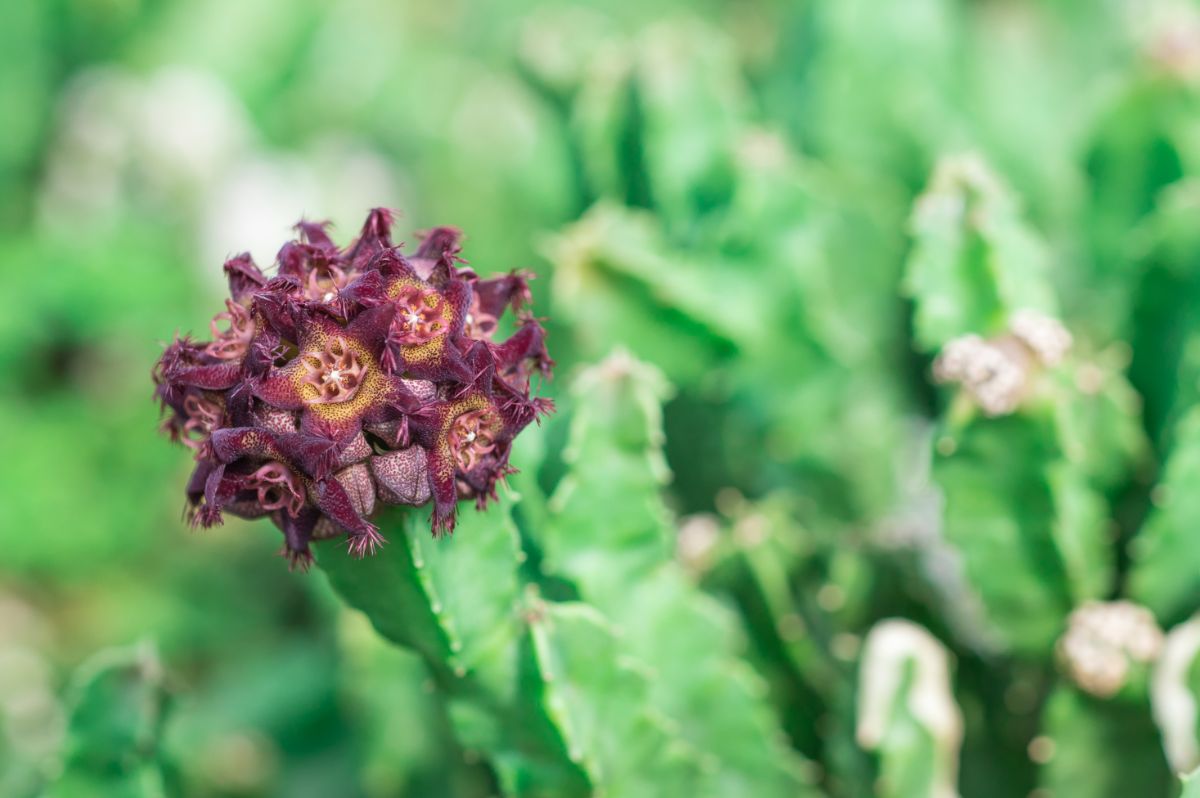
| Scientific Name: | Caralluma fimbriata |
| Plant Type: | perennial |
| Geographic Origin: | India |
| Plant Size: | 8-24 inches tall |
| Sun Exposure: | full to partial |
| Plant Zone: | 10-12 |
Caralluma is a cactus known for its striking red and yellow flowers. Caralluma prefer full sun and should not be over-watered, and the plants do not tolerate cold temperatures.
Caralluma grows slowly and requires a dormant period during the winter months. Cacti can grow in rocky areas by allowing bacteria to grow in their root system. These bacteria slowly consume rocks and pass nutrients into the cacti.
Conophytum
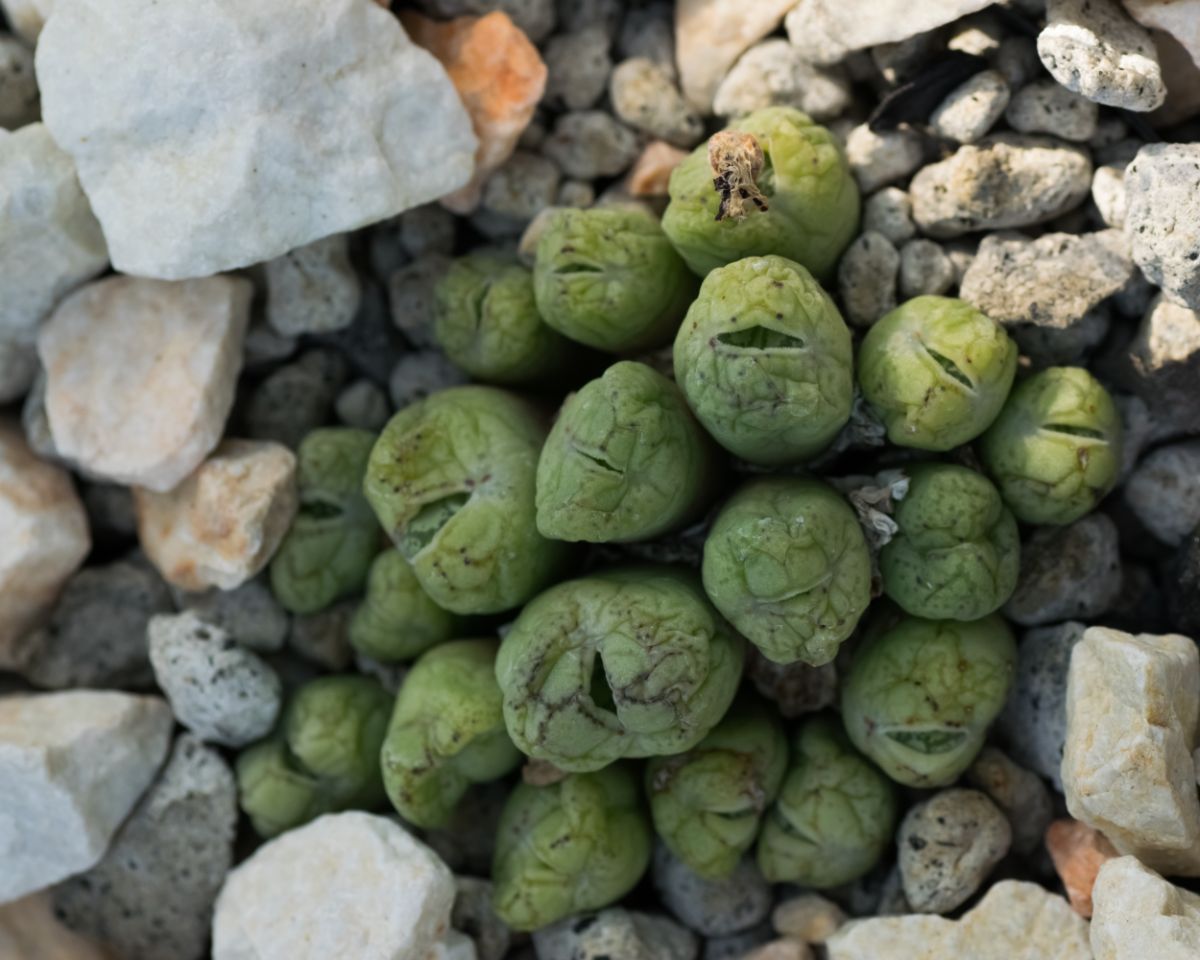
| Scientific Name: | Conophytum ficiforme |
| Plant Type: | perennial |
| Geographic Origin: | South Africa |
| Plant Size: | 1-3 inches tall |
| Sun Exposure: | full to partial |
| Plant Zone: | 10-12 |
Conophytum (Button Plant) is a genus of succulent plants that includes more than one hundred species. Conophytums are native to South Africa and Namibia. They typically have thick, fused leaves and yellow and orange flowers.
You know it's time to water a conophytum when the leaves look wrinkled. However, it's important not to let the roots sit in water because they will rot.
Malephora
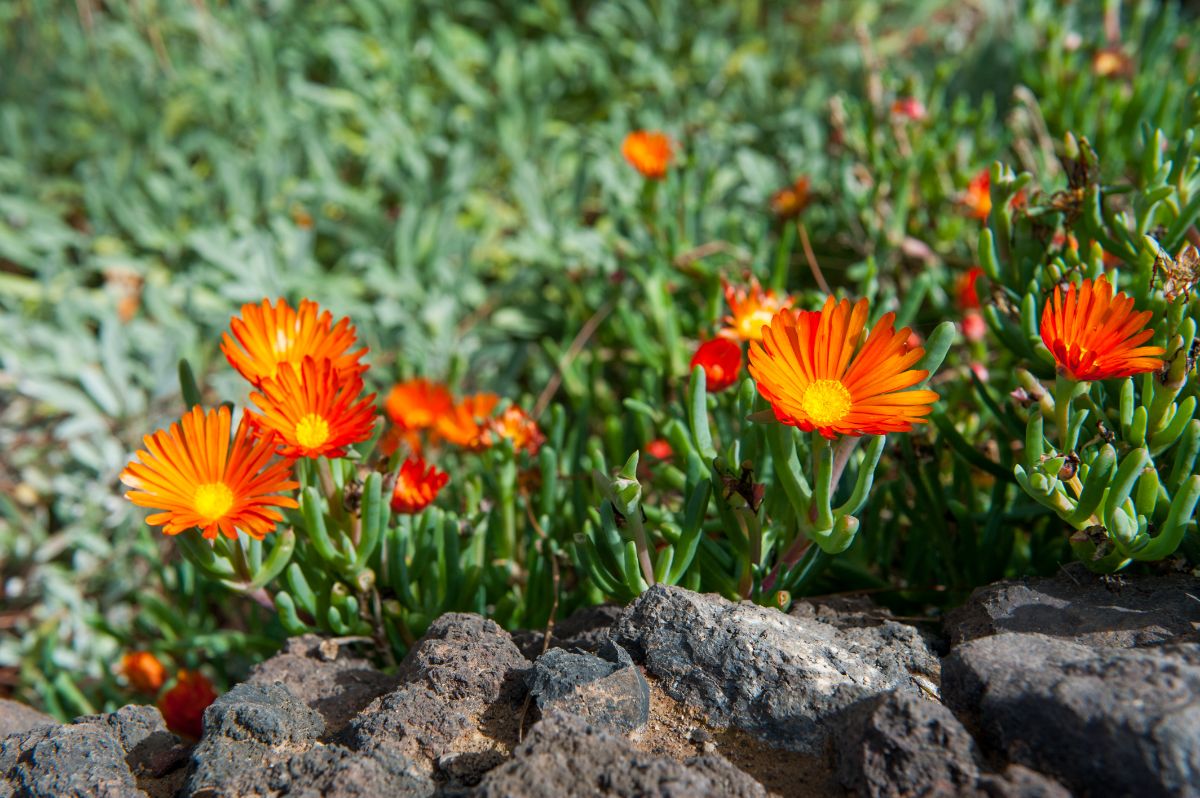
| Scientific Name: | Malephora crocea |
| Plant Type: | perennial |
| Geographic Origin: | Southern Africa |
| Plant Size: | 10-12 inches |
| Sun Exposure: | full |
| Plant Zone: | 9-12 |
Malephora (Red Ice Plant) is a genus of succulent plants that creep up to eleven inches. The flowers are red, orange, or pink, and blue-green leaves.
Malephoras are popular in rock gardens because they are durable and require little water. This plant grows quickly and prefers full sun.
How To Grow Plants on Rocks
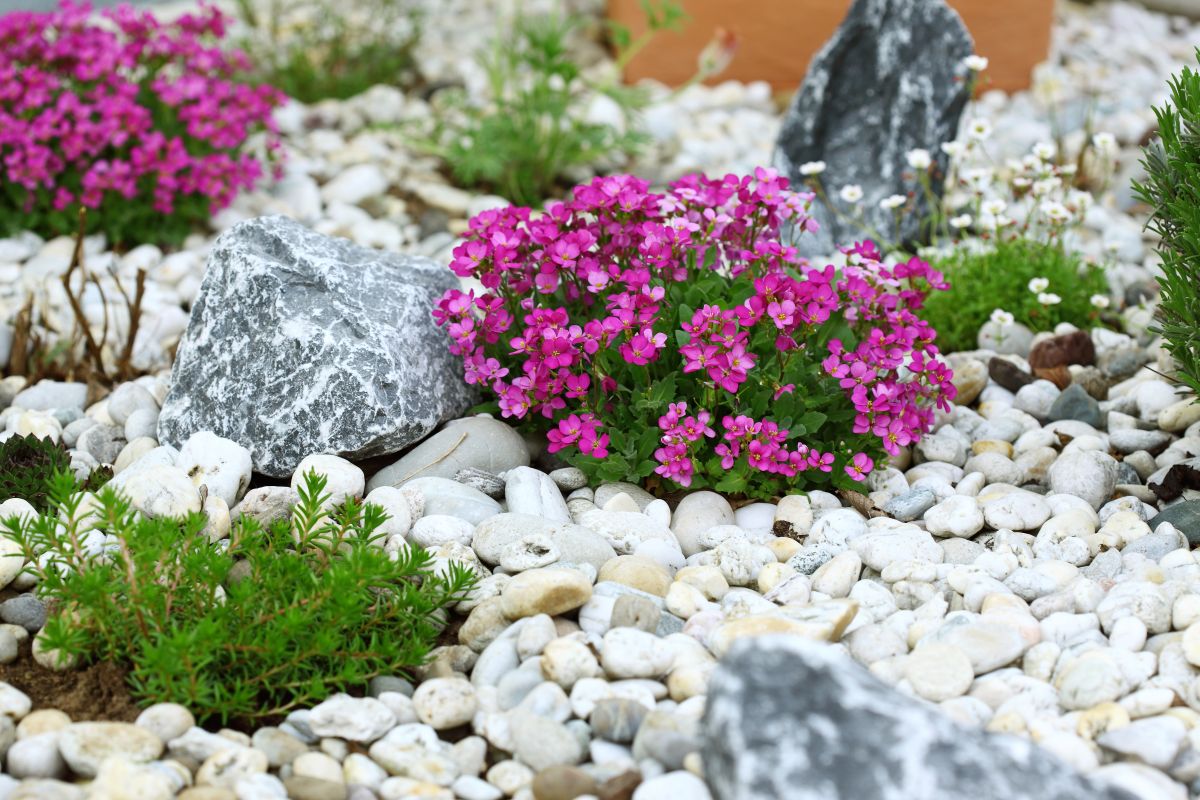
Growing plants on rocks can be a challenge, but it can also be gratifying. Here are some tips on how to pull it off successfully:
Choose the Right Plants
Some plants are better suited for growing on rocks than others. Look for plants with shallow root systems that don't require a lot of soil. Succulents and cacti are good examples of plants that can grow on rocks.
Prepare the Rocks
Make sure the rocks you choose are clean and free of debris. You can soak them in bleach to sterilize them if necessary.
Create a Drainage Layer
Before you plant, create a layer of gravel or sand on the bottom of the planter. This layer will help to ensure that things don't get waterlogged.
Fill the Planter With Soil
Use a light, well-draining soil mix. You can find this type of soil at most garden centers.
Plant Your Plants
Gently place each plant in the soil, ensuring that the roots are covered. Once all of the plants are in place, water them well.
Place the Planter in a Sunny Spot
Most plants need full sun to thrive, so choose a location that gets plenty of sunlight.
With care and attention, you can successfully grow plants on rocks.
How To Create a Rock Garden
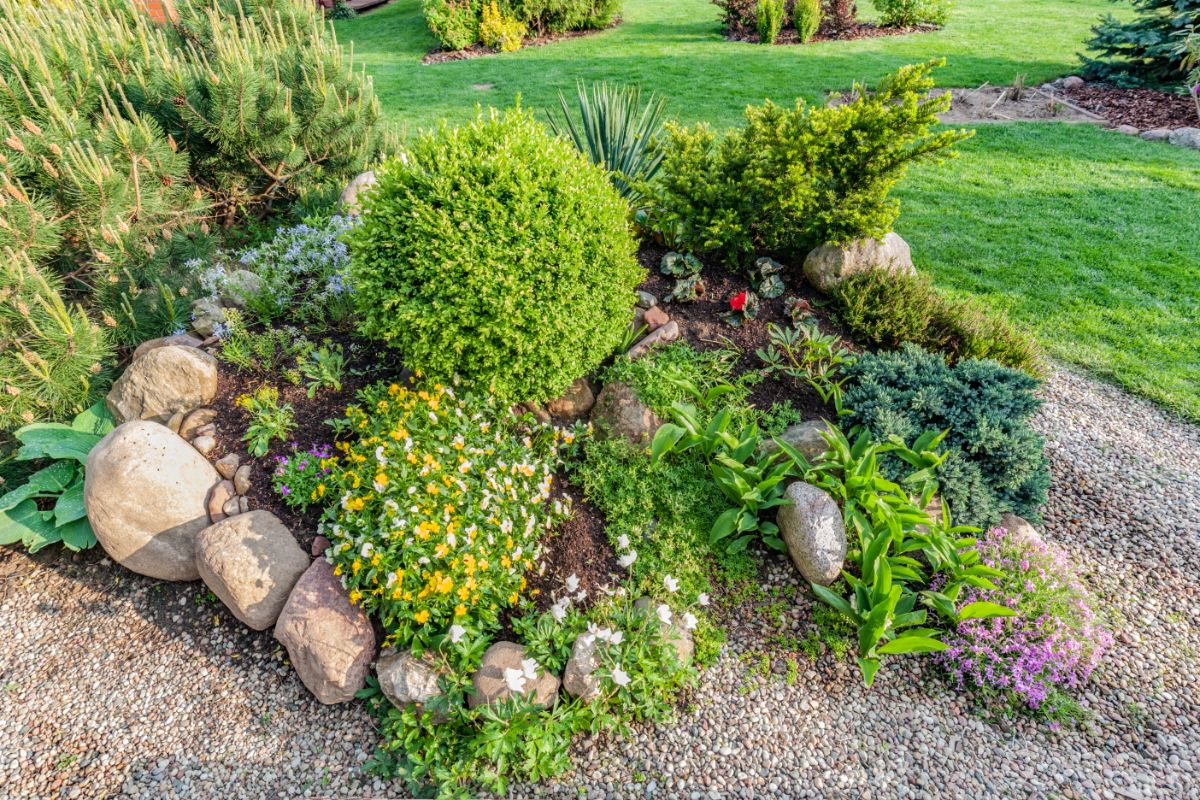
A rock garden is a type of garden that uses rocks or stones as a significant component in the design. You can create rock gardens using natural and artificial materials, and the designs often resemble miniature landscapes.
If you're interested in creating your rock garden, there are a few things you'll need to keep in mind. First, you'll need to choose a location for your garden.
It's crucial to pick a spot that gets plenty of sunlight, as most plants and flowers that do well in rock gardens require at least six hours of daylight each day. Once you've found the perfect spot, you'll need to gather your materials.
Using natural materials, you'll need to collect rocks of various sizes. It's best to look for stones that have smooth surfaces, as these will be the easiest to handle.
Once you've gathered your rocks, you'll need to start creating the base for your garden. You can achieve this by digging a trench or hole and lining it with stones.
If you're using artificial materials, you'll need to purchase rocks or stones from a local garden center. Again, it's best to choose smooth rocks for your garden.
Once you have everything ready, you'll need to create the base for your garden in the same way as described above.
Once you've created the base for your garden, you can start adding plants and flowers. When choosing plants for your rock garden, it's essential to pick hardy and drought-tolerant ones.
Succulents are a great option, as they require very little maintenance and can tolerate long periods of drought. Once you've added your plants, you can finish your garden by adding mulch or soil to cover the exposed roots.
Creating a rock garden is a great way to add interest to your landscape. With a bit of planning and effort, you can create a beautiful and unique garden that will be the envy of your neighbors.
Rock plants are some of the most low-maintenance, easy-to-care-for plants.
Consider adding a few plants from this article if you're looking for an exciting way to add a little bit of life to your garden or outdoor space.
These plants require very little maintenance, and they come in a variety of shapes and colors, making them an excellent option for adding some visual interest to your space.

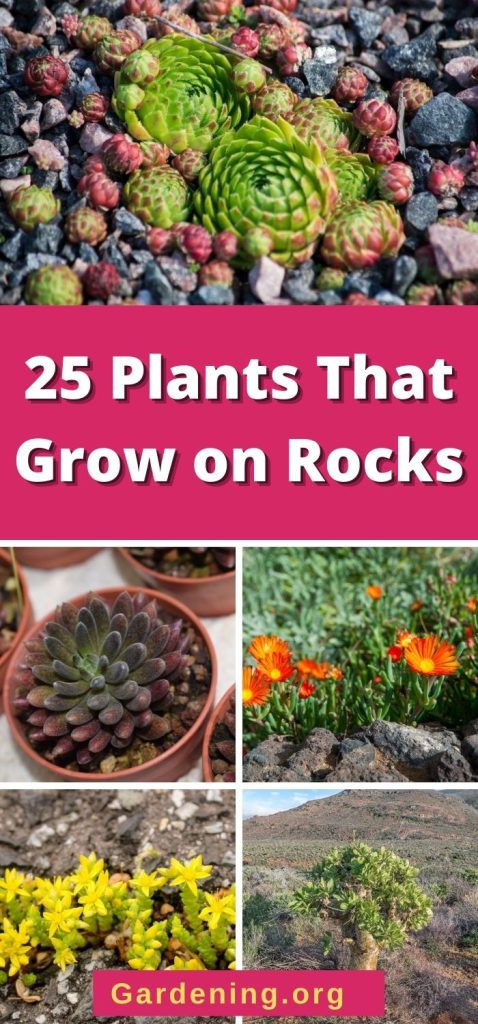
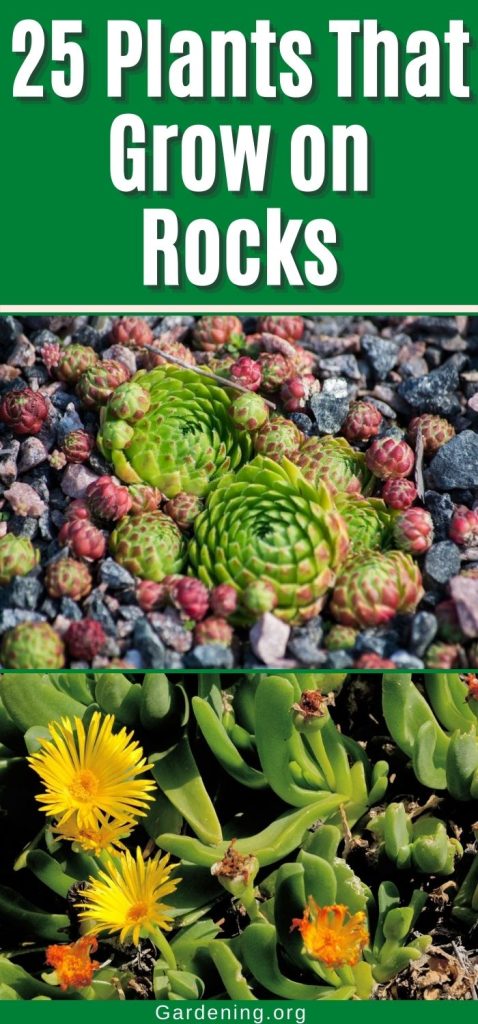






Leave a Reply